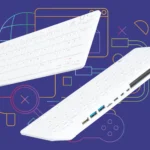Back in the 1980s electronic games were the best thing you could get if your parents couldn’t afford an Atari or a computer. Handheld systems, robots, and electronic (and pretty noisy) games were everywhere.
This list covers the top 20 battery-powered, portable 1980s electronic games and toys kids wanted 40 years ago (in no particular order).
1. The ultimate in 1980s electronic games: Nintendo Game and Watch 1980-1991
Perhaps the ultimate 1980s electronic games, the Nintendo Game & Watch was a series of handheld electronic games first released in 1980. It featured a single game and a digital clock, hence the name. The game was played on a monochrome LCD screen, while the device was powered by a button cell battery. A variety of different games were available, ranging from simple maze and puzzle games to more complex action games. Some were standard handhelds, but others folded in landscape or portrait mode, a design cue that was revisited by the Nintendo DS.
The Game & Watch was one of the earliest handheld game consoles, and it paved the way for other 80s Nintendo handheld games, and later devices like the Game Boy. Today, it is considered a classic piece of gaming history and original 80s Nintendo games devices are highly sought after by collectors.
(More recently, the Game & Watch form factor has been revived with some special releases.)
2. Grandstand Mini Munchman
First you had Munchman, then Mini Munchman, a pocket-sized variant. The game is a rebadged Epoch-Man, which is Epoch’s Pac-Man clone, rather than Grandstand’s. While Munchman featured coloured LEDs and changing maps, Mini Munchman relied on monochrome LCD and a repeated map with increasing difficulty.
For kids who didn’t get to go into arcades and bars, and didn’t have an endless supply of 10p pieces, Mini Munchman was the closest you got to playing Pac-Man while out and about. Interestingly, while Munchman “borrowed” the Pac-Man chime (and shifted it up a key), Mini Munchman has its own music.
Later, Mini Munchman became Pocket Pac-Man, presumably after more licensing shenanigans.
3. One of the top 1980s electronic games: Tomytronic 3D 1983
Three of these stereoscopic 3D gaming systems were released.
While the advert might exaggerate the graphics (coloured LED cels), these amazing games were actually pretty addictive. Sure, you had to hold the controllers like binoculars and this could get tiring, but they were fun, despite the limited audio.
If you can get hold of a TomyTronic 3D game, give it a go — easily one of the most impressive 1980s electronic games.
4. Grandstand BMX Flyer
Back in 1986 I had a C64 but I still fancied a portable game console. I was well into BMXs — racing, rather than stunts — and BMX Flyer looked like the ultimate choice.
This is the point where I share an oft-supressed memory of my entry into a BMX race at the local racecourse, where a course had been carved out of the landscape. Having never broken into the racecourse and tried the course beforehand, I finished last, despite getting the fastest start.
The game I ended up with was BMX Burner, a perfectly good 1980s electronic game that still works, but missing the colour and some of the obstacles… and ironically being more race-based than stunt. (More on that below…)
5. Coleco Total Control 4
Released in 1981, this handheld gaming system was not widely available in the UK, although some larger stores stocked it. The game featured four display overlays for each of the different games: hockey, American football, basketball, and football (soccer).
Perhaps most notable is the Coleco Total Control 4’s two player mode. In a time when handheld gaming was basically a sequence of red LEDs (as with this console), pulling off two player gaming is quite surprising.
6. Memorable 1980s electronic games: Tomy Caveman
This was a clightly chunky tabletop game, released by Tomy (Radioshack/Tandy in the USA), in which you have to steal eggs from a dinosaur. Various hazards slow you down, such as pterodactyls and lava, and the dinosaur incredibly breathes fire.
You need 8 eggs to progress to the next level, which isn’t too difficult, but once the pterodactyl turns up, you have to defend the eggs you’ve stolen. Sporting colourful LEDs, all that seperates your caveman from death is a hammer and fast reactions.
If you don’t think you’ll be able to find a physical version of one of the most popular 1980s electronic games, you can play Tomy Caveman in your browser.
7. Big Trak
Big Trak is a programmable toy robot designed for children that was first released in 1979. It featured six wheels, a retractable front-mounted “photon cannon” and a keypad that allowed children to input a series of commands to direct the robot’s movements.
Commands could be programmed in advance, allowing the Big Trak to navigate through a series of pre-defined routes or perform a variety of tasks. It was powered by batteries and had a range of approximately 30 feet. The Big Trak was one of the first programmable toys and was a popular educational tool for teaching children basic programming concepts.
Where I lived, every kid in the 80s wanted this electronics toy.
Toy collectors and retro-tech enthusiasts consider Big Trak a classic. These days, it is often mimicked using modern micro-controllers, such as the Raspberry Pi.
8. Grandstand Scramble
A tabletop/portable version of the popular Scramble arcade game, the Grandstand version was far more difficult. This was mainly due to the control mechanism, which made the game play like a brick.
Yes, I’m still bitter, and while it might be useful for completists, unless you have warm memories of this game (these 1980s electronic games tended to get hot), if you have money to spend, aim for something else.
Like an arcade cabinet or table of Scramble, which will be infinitely more fun than this.
9. Grandstand Astro Wars
This handheld 80s video game resembled a radar unit, offering a multicoloured experience that relied on a few coloured LEDs to transport you into outer space and destroy aliens.
Of course, with a name like “Astro Wars” you’ve probably worked out what the game is really all about. It’s essentially Space Invaders, requiring you simply dodge and shoot your way to victory.
A basic left-right controller and fire button was all you needed to blast the ETs into smithereens. A few of these units are still around today – if you have one without a badly scratched display, keep your hands on it!
10. LEGO Light & Sound Range
In fairness, this probably demands a list all of its own. In the 1980s, following the success of the LEGO trains and Technic system, the Light & Sound range was released. This added LEDs and basic sound effects to various vehicle types, from about-town vehicles to spaceships.
They looked and sounded unlike anything else at the time, but unfortunately were noticeably more expensive than kits without these enhancements. Despite this, the Light & Sound Lego range remain some of the most memorable 1980s electronic toys and games — and if they’re still working, are worth a lot of money…
11. 1980s electronic games everyone had: Super Kong
Unsurprisingly, Super Kong is a Nintendo Donkey Kong clone, using coloured LEDs and a printed screen border. Incredibly, no legal action was taken by Nintendo for this, which is incredibly close to the original game.
The only real difference is that Super Kong uses a single screen, a small joy/thumbstick, and doesn’t fold in half when you’re done. However, fake as it may be by modern standards, this unlicensed game was the only way to play a Donkey Kong-style game for many people.
Of course, there was the arcade game, and the computer and console version, but they take time to load. Also, they don’t fit into your pocket.
12. Tandy Championship Golf
Unlike many of the games in this list, Tandy Championship Golf isn’t based on an arcade game. Relying mainly on how hard you push the golf ball button, this is an example of an electronics/paper hybrid, as the game ships with a paper score sheet.
Essentially a collection of red LEDs that represent the position of the ball, this isn’t a sophisticated game. However, it is bloody addictive.
(Interesting fact: this 1980s electronic game was still listed in Tandy catagolues in the UK into the 1990s.)
13. Grandstand BMX Burner
For Christmas 1984 I wanted the Grandstand BMX game, but for whatever reason, I got something else: Grandstand BMX Burner. Naturally, I was disappointed; happily, that didn’t last for long.
Relying on standard monochomre LCD rather than the slightly more colourful graphics of the other game, this 1980s game was nevertheless a challenge that took up plenty of my time.
In fact, showing it to my cousin one time, she found it far more interesting than her Nintendo Game & Watch.
While the Grandstand games weren’t as sophisticated as Nintendo’s offerings, they were fun and engaging in their own way.
14. Grandstand Firefox
One of the best-remembered 1980s electronic games, this was more Harrison Ford than Clint Eastwood.
Kicking off with a Thunderbirds chime and six levels, this is a fast-paced game that appears to be based on the electronic targeting computer in Star Wars. The enemy ships also resemble TIE Fighters, and overall, thanks to the three difficulty levels, it’s pretty tough.
But the colour LEDs make it a visually pleasing experience, the SFX are good, and it’s a playable 1980s electronic toy — enough to make you want to go back again and again.
15. Tomy Racing Turbo
The genius of the Tomy Racing Turbo was that it essentially mimicked Atari’s Night Driver, using a light projection system. Of course, this unit was far smaller, about the same size as one of those “backseat driver” toys for kids, and relied on a few batteries.
Like the Tomy 3D systems, Tomy Racing Turbo was endlessly replayable. It was a top toy for taking places, was good for two player challenges, and could stand in for a real car if you were playing make believe games (remember those?).
16. Simon (MB Games)
It was bright, colourful, and noisy, and an absolute classic of the 80s electronic games scene. Simon was essentially the electronic version of Rubik’s Cube – everyone had one, regardless of whether they could play the short term memory game or not.
Except us. However, at least one of my cousins had it, so I can write about this one from a position of unique insight: I hated it. I hated the noice, the speed, the pointlessness of trying to copy the sequence (as in the game “Simon Says”).
Yet I still wanted one, so that was obviously a win for MB Games.
17. Tomy Alien Attack
A Scramble clone from a well-known electronics toy producer, Alien Attack was one of the more popular examples of table top videogames among school kids in the 1980s.
Sporting some nice coloured LEDs — a trademark of Tomy’s games that would eventually be evolved into the stereoscopic 3D games — this is nevertheless one of the worst ways to play Scramble. The controls just don’t cut it, in my opinion, leaving this as a popular toy that we played because it was like an arcade game that you had at home, rather than it being any good.
18. Grandstand Gauntlet
Released by Tiger in the USA, Gauntlet was one of several titles (Double Dragon another) given the woefully unsuitable handheld monochrome LCD treatment in the late 1980s.
While not a great version of Gauntlet, this is nevertheless not all that bad. The dungeon map may seem limited at first glance, but it actually has quite a bit of depth. Playing without consulting the instructions first is a mistake, however.
Gauntlet was the best of these arcade conversions, so is worth checking out if you can get your hands on one.
19. Omnibot
Toy robot Omnibot was first released by Tomy in 1984. It was designed to be an interactive companion for children, featuring a range of different sensors and functions. The Omnibot could be programmed to respond to voice commands, navigate around obstacles, and perform a variety of actions. These included dancing, or playing music, and featured a remote control to direct its movements.
While this electronic toy from the mid 1980s was mostly used to play stories or listen to music, Omnibots really made kids feel like they owned a real robot!
20. One of the 1980s electronic games everyone had: Frogger
We’ll finish with a game that qualifies as a bona fide classic. You probably know Frogger as an 8-bit Konami title on the Atari 2600 and various other early 80s systems. The aim is simple: get the frog safely across the road. It is, of course, the forerunner to Crossy Road.
The 1980s electronic handheld version of Frogger features two game modes with differing difficulty. While you can’t exactly stick it in your pocket, the electronic handheld version of Frogger remains a classic.
Unmissable 1980s electronic games
These games and toys – and many more – made life bearable in the 80s. Electronic games would evolve throughout the decade; just a few years into the 1990s we were into the PlayStation era.
The 1980s handheld games relied as much on batteries as they did imagination – and we loved them for it.
Any favourite 1980s electronic games we’ve missed? Let us know!
Affiliate Disclosure: Some of the links in this post may be affiliate links, which means I may earn a small commission if you make a purchase through those links. This comes at no extra cost to you. Thank you for your support!
Christian Cawley is a writer and editor who covers consumer electronics, IT, and entertainment media. He has written for publications such as Computer Weekly, Linux Format, MakeUseOf.com, and Tech Radar.
He also produces podcasts, has a cigar box guitar, and of course, loves retro gaming.








